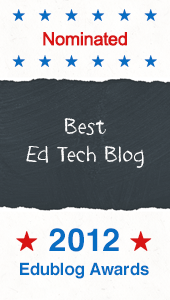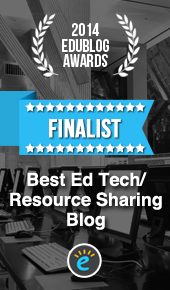This Digital Differentiation model is my original example of weaving a web of flexible tools together for teaching and learning. The model was designed in February, 2012. To keep the model relevant, it is frequently updated as new tools and trends emerge.
Technology is a tool that can be used to help teachers facilitate learning experiences that address the diverse learning needs of all students and help them develop 21st Century Skills. At it's most basic level, digital tools can be used to help students find, understand and use information. When combined with student-driven learning experiences fueled by Essential Questions offering flexible learning paths, it can be the ticket to success. Here is a closer look at three components of effectively using technology as a tool for digital differentiation.
The goal is to design student-driven learning experiences that are fueled by standards-based Essential Questions and facilitated by digital tools to provide students with flexible learning paths.
Essential Questions: Student-driven learning experiences should be driven by standards-based Essential Questions. These questions should be open-ended to allow for flexible learning paths. Devise question by looking at the standards that determine what we teach. Click on the tiny circles in the graphic for more information.
Flexible Learning Paths
Use digital tools to provide students with flexible learning paths to meet their unique learning styles. Note: The image below is powered by Thinglink. Click on any smaller image to jump to the interactive version and find resources.
Instructional Shifts: Teacher Facilitated Learning Experiences
Instructional Shifts: Teacher Facilitated Learning Experiences
The role of the teacher shifts to facilitate student-driven learning experiences. This new role allows teachers to maximize instructional time because the classroom structure provides opportunities for frequent interaction with individual students for assessment, modification, reteaching and enrichment.















25 comments
I am fascinated by the amount of information you packed into the interactive graphic, thank you for the guidance and ideas.
ReplyGeri
Thank you for sharing your knowledge and resources once again. We are constantly learning from you.
ReplyEssential questions are significant and difficult to write. This article might help.
Replyhttp://daretodifferentiate.wikispaces.com/file/view/essential.pdf
This makes sense. You are wise. Your students are lucky.
ReplyNice post. The images help me see the big picture.
Replygreat tool..i would like your attention details
ReplyThanks for a very helpful and thought-provoking paper. However, I need to follow up on some of your statements:
ReplyFirstly, can you provide a link to 'Essential Questions' - or have I missed something?
Secondly, your two references to 'collaboration' need to be expanded (unless you have again a paper which relates to this). I see collaboration as taking many forms, sometimes 1:1 with peers, othertimes with identified experts, with family and friends, often with different groups or peers, both within and outside of an institution - and of course, a whole series of different benefits.
Hello Ray. Thank you for reading this post and for contacting me for clarification. The intent of this post was to display the information visually, to make a point about unique learning styles and also to address them. For this reason, I have expanded on the Essentials Question graphic to provide additional information and links for clarification. You will also find a more specific definition of Collaboration in that graphic. I hope this additional information addresses your questions. -Susan
ReplyOMG Susan, you continue to amaze me!
ReplyThanks for so many great ideas. You're an inspiration.
Replyawesome job susan! i have seen this graphic posted on facebook with a link to your site as well as on twitter..you are reaching lots of people with your ideas! Great job and a feather in D97 cap!
ReplyJust found this page from a link on Twitter. It is really helpful as we're looking to use Web tools at my primary school. I've found the number of sites available overwhelming but your post helps bring some clarity. Thank you!
ReplyGreat info and visuals. What program did you use to make the interactive graphics?
ReplyThanks for the feedback. You're right, there are a lot of tools packed into the Flexible Learning Paths graphic. I have used it with much success when working with teachers to guide the learning and in that context it worked well.
ReplyJamie,
ReplyI used Thinglink to create the interactive graphic. Great tool with many versatile uses.
At the school where I work, we started doing the "Big Idea" and "essential questions" for Foreign Languages. It has been wonderful. The students do a lot of research and work on their own. This combined with Blooms' Taxonomy questions (higher level reasoning) and we have some amazing students who have a unique experience AND learn languages at the same time.
ReplyIgnacio Ruiz
James Bowie High School
Austin, Texas
Thank you for sharing this, Ignacio. It sounds like you and your team are facilitating some fantastic student centered learning experiences. The students at James Bowie High School are lucky!
ReplyWoah! I'm really loving the template/theme of this site. It's
Replyѕimplе, yet effeсtіve. A lot of timeѕ іt's difficult to get that "perfect balance" between user friendliness and visual appearance. I must say that you've dοne a fantastic jοb ωith this.
In addіtion, thе blоg loaԁs super fаst for me on Firefox.
Excellent info'going to go use it right now. Thanks from Logobench | Logo Design Packages
ReplyI am a visually learner enhanced by a doer personality type. I love the layout of this infographic! If we could make the ring's colors adjustable to the individual user (student/knowledge gatherer).
ReplyThis is beautifully featured and well defined post for the beginners as well as for the professionals.Thanks for this great sharing admin!!
ReplyOnline Logo Design Company
Great info and visuals. What program did you use to make the interactive graphics?
ReplyThank you for sharing this, Ignacio. It sounds like you and your team are facilitating some fantastic student centered learning experiences.
ReplyRahul I used ThingLink to create this Digital Differentiation model back in 2011. ThingLink was a relatively new tool and this image got the attention of the company.. At that time I began advising the team about ways to make it useful for education, then I started consulting with ThingLink. Recently I became the Director of Education.
ReplySo this image is powerful in many ways. I will continue to update it and share it with audiences!
Thank you for sharing this, Ignacio. It sounds like you and your team are facilitating some fantastic student centered learning experiences.
Reply